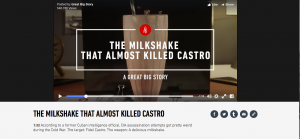By ROXANNE YU
Even if an incredible amount of time is dedicated to the tedious marriage planning process, a perfect wedding day is never guaranteed.
There are just certain things over which wedding planners don’t have control .
Every bride dreams of a picture perfect wedding day when her daddy walks her down the aisle, but so many different things can go wrong. I’m not talking about a dress malfunction, rather a more contending force of nature that is well beyond human control — the weather.
What happens when the bride and groom are in the middle of exchanging vows in a beach wedding and it starts to storm?
Seems like members of our society have once again outdone themselves by creating a solution for rainy wedding days.
Based from an article released by CNN, rain-free wedding days are now offered by a UK-based travel company. A technique called “cloud seeding,” a scientific method to increase precipitation patterns is made use of during this process. The catch: to ensure a sunny day, it will cost you $150,000.
Although the article could have added additional information about the process of cloud seeding as a whole, it did a great job of catering to a broader audience. For obvious reasons, the target audiences are engaged couples, however, the writer, Jon Jensen, was able to transform the scientifically grounded topic of cloud seeding to appeal to the general public.
Jensen was able to attract a less scholarly crowd by discussing what cloud seeding is all about through means of reducing the use of complicated scientific terms. Also, the inclusion of humor in Jensen’s article, as well as incorporating a scaled pinch of mockery towards the idea of paying a large amount for a sunny day, did make the article engaging. In fact, before he ends his article, he writes a “Do it Yourself” 5 step outline, which is particularly for those who don’t want to spend $150,000 to stop the rain.
Other than that, the only thing Jensen could have included was success stories of married couples who paid the $150,000 fee. The aspect of incorporating more sources would have made his article more credible as a whole.


 o help his parents support his six other siblings.
o help his parents support his six other siblings.
 Brandi Chastain, former U.S. national soccer team member, just announced that she will be donating her brain to Boston University for
Brandi Chastain, former U.S. national soccer team member, just announced that she will be donating her brain to Boston University for